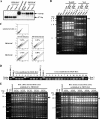Distinctive effects of the Epstein-Barr virus family of repeats on viral latent gene promoter activity and B-lymphocyte transformation
- PMID: 19570868
- PMCID: PMC2738248
- DOI: 10.1128/JVI.01979-08
Distinctive effects of the Epstein-Barr virus family of repeats on viral latent gene promoter activity and B-lymphocyte transformation
Abstract
The Epstein-Barr virus (EBV), a human B-lymphotropic gamma herpesvirus, contains multiple repetitive sequences within its genome. A group of repetitive sequences, known as the family of repeats (FR), contains multiple binding sites for the viral trans-acting protein EBNA-1. The FR sequences are important for viral genome maintenance and for the regulation of the promoter involved in viral latent gene expression. It has been reported that a palindromic sequence with a putative secondary structure exists at the 3' end of the FR in the genome of the EBV B95-8 strain and that this palindromic sequence has been deleted from the FR of the commonly used EBV miniplasmids. For the first time, we cloned an EBV B95-8 DNA fragment containing the full-length FR, which enabled us to examine the functional difference between full-length and deleted FRs. The full-length FR, like the deleted FR, functioned as a transcriptional enhancer of the viral latent gene promoter, but that transactivation was significantly attenuated in the case of the full-length FR. No significant enhancement of replication was observed when the deleted FR was replaced with the full-length FR in an EBV miniplasmid. By contrast, when the same set of FR sequences were tested in the context of the complete EBV genome, the full-length FR resulted in more-efficient B-cell transformation than the deleted FR. We propose that the presence of the full-length FR contributes to the precise regulation of the viral latent promoter and increases the efficiency of B-cell transformation.
Figures







Similar articles
-
Unexpected instability of family of repeats (FR), the critical cis-acting sequence required for EBV latent infection, in EBV-BAC systems.PLoS One. 2011;6(11):e27758. doi: 10.1371/journal.pone.0027758. Epub 2011 Nov 16. PLoS One. 2011. PMID: 22114684 Free PMC article.
-
Residues 231 to 280 of the Epstein-Barr virus nuclear protein 2 are not essential for primary B-lymphocyte growth transformation.J Virol. 1998 Dec;72(12):9948-54. doi: 10.1128/JVI.72.12.9948-9954.1998. J Virol. 1998. PMID: 9811732 Free PMC article.
-
Identification of a promoter for the latent membrane protein 1 gene of Epstein-Barr virus that is specifically activated in human epithelial cells.DNA Cell Biol. 1997 Jul;16(7):829-37. doi: 10.1089/dna.1997.16.829. DNA Cell Biol. 1997. PMID: 9260926
-
EBNA2 and Its Coactivator EBNA-LP.Curr Top Microbiol Immunol. 2015;391:35-59. doi: 10.1007/978-3-319-22834-1_2. Curr Top Microbiol Immunol. 2015. PMID: 26428371 Review.
-
[Epstein-barr virus gene expression in latent infection and B-lymphocyte growth transformation].Uirusu. 2002 Jun;52(1):129-34. Uirusu. 2002. PMID: 12227161 Review. Japanese. No abstract available.
Cited by
-
Epstein-Barr virus strain variation and cancer.Cancer Sci. 2019 Apr;110(4):1132-1139. doi: 10.1111/cas.13954. Epub 2019 Feb 21. Cancer Sci. 2019. PMID: 30697862 Free PMC article. Review.
-
Augmented latent membrane protein 1 expression from Epstein-Barr virus episomes with minimal terminal repeats.J Virol. 2010 Mar;84(5):2236-44. doi: 10.1128/JVI.01972-09. Epub 2009 Dec 16. J Virol. 2010. PMID: 20015988 Free PMC article.
-
Unexpected instability of family of repeats (FR), the critical cis-acting sequence required for EBV latent infection, in EBV-BAC systems.PLoS One. 2011;6(11):e27758. doi: 10.1371/journal.pone.0027758. Epub 2011 Nov 16. PLoS One. 2011. PMID: 22114684 Free PMC article.
-
Tetrameric ring formation of Epstein-Barr virus polymerase processivity factor is crucial for viral replication.J Virol. 2010 Dec;84(24):12589-98. doi: 10.1128/JVI.01394-10. Epub 2010 Oct 6. J Virol. 2010. PMID: 20926567 Free PMC article.
-
Herpesvirus BACs: past, present, and future.J Biomed Biotechnol. 2011;2011:124595. doi: 10.1155/2011/124595. Epub 2010 Oct 27. J Biomed Biotechnol. 2011. PMID: 21048927 Free PMC article. Review.
References
-
- Baer, R., A. T. Bankier, M. D. Biggin, P. L. Deininger, P. J. Farrell, T. J. Gibson, G. Hatfull, G. S. Hudson, S. C. Satchwell, C. Seguin, et al. 1984. DNA sequence and expression of the B95-8 Epstein-Barr virus genome. Nature 310:207-211. - PubMed
-
- Floettmann, J. E., K. Ward, A. B. Rickinson, and M. Rowe. 1996. Cytostatic effect of Epstein-Barr virus latent membrane protein-1 analyzed using tetracycline-regulated expression in B cell lines. Virology 223:29-40. - PubMed
-
- Fruscalzo, A., G. Marsili, V. Busiello, L. Bertolini, and D. Frezza. 2001. DNA sequence heterogeneity within the Epstein-Barr virus family of repeats in the latent origin of replication. Gene 265:165-173. - PubMed
Publication types
MeSH terms
Substances
LinkOut - more resources
Full Text Sources

